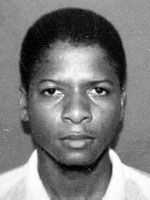Ahmed Ghailani | |
|---|---|
 Ahmed Khalfan Ghailani (FBI photo) | |
| Born | March 14, 1974 |
| Organization | Al-Qaeda |
| Criminal status | Incarcerated |
| Spouse | Married |
| Conviction(s) | Conspiracy to destroy buildings and property of the United States resulting in death (18 U.S.C. § 844) |
| Criminal penalty | Life imprisonment without parole |
Date apprehended | July 25, 2004, in Gujrat, Pakistan |
| Imprisoned at | USP McCreary |
Ahmed Khalfan Ghailani (Arabic: أحمد خلفان الغيلاني, Aḥmad Khalifān al-Ghaīlānī; born March 14, 1974) is a Tanzanian conspirator of the al-Qaeda terrorist organization convicted for his role in the bombing of embassies in Kenya and Tanzania.[1][2] He was indicted[3][4] in the United States as a participant in the 1998 U.S. embassy bombings. He was on the FBI Most Wanted Terrorists list from its inception in October 2001. In 2004, he was captured and detained by Pakistani forces in a joint operation with the United States, and was held until June 9, 2009, at Guantanamo Bay detention camp;[5] one of 14 Guantanamo detainees who had previously been held at secret locations abroad.[6] According to The Washington Post, Ghailani told military officers he is contrite and claimed to be an exploited victim of al-Qaeda operatives.[7]
Ghailani was transported from Guantanamo Bay to New York City to await trial in the United States District Court for the Southern District of New York in June 2009.[8] When the case came to trial, the judge disallowed the testimony of a key witness. On November 17, 2010, a jury found him guilty of one count of conspiracy, but acquitted him of 284 other charges including all murder counts.[9] Critics of the Obama administration said the verdict proves civilian courts cannot be trusted to prosecute terrorists since it shows a jury might acquit a defendant entirely.[9] Supporters of the trial have said that the conviction and the stiff sentencing prove that the federal justice system works.[10]
On January 25, 2011, U.S. District Judge Lewis A. Kaplan, the presiding judge in the case, sentenced Ghailani, believed to be 36 years old at the time, to life in prison for the bombing,[1][2] stating that any suffering Ghailani experienced at the hands of the CIA or other agencies while in custody at Guantanamo Bay pales in comparison to the monumental tragedy of the bombings of the U.S. embassies in Kenya and Tanzania in 1998, which killed 224 people, including 12 Americans, and left thousands injured or otherwise impacted by the crimes. The attacks were one of the deadliest non-wartime incidents of international terrorism to affect the United States; they were on a scale not surpassed until the September 11 attacks three years later. Ghailani, who had said he was never involved and did not intend to kill anyone, had been portrayed as cooperating with investigators—yielding information wanted by investigators—and as remorseful by his defense counsel, but that argument of relative non-involvement or remorse was not accepted. He is the fifth person to be sentenced. Four others were sentenced to life in prison in a 2001 trial in Manhattan federal court. Osama bin Laden was also named in the indictment.[11]
- ^ a b Richey, Warren (January 25, 2011). "Ahmed Ghailani gets life sentence for Al Qaeda bombing of US embassies". Christian Science Monitor. Archived from the original on January 31, 2011. Retrieved January 26, 2011.
- ^ a b Hays, Tom (January 25, 2011). "Gitmo Detainee Gets Life Sentence in Embassy Plot". Associated Press. Retrieved January 26, 2011.
- ^ Copy of indictment: USA v. Usama bin Laden et al., Center for Nonproliferation Studies, Monterey Institute of International Studies; accessed November 19, 2014.
- ^ "Superseding Indictment (U.S v. bin Laden, et al.)". FindLaw. March 2001. Retrieved June 9, 2009.
- ^ "Detainee Biographies" (PDF). Office of the Director of National Intelligence. Archived from the original (PDF) on November 19, 2009.
- ^ Bush: CIA holds terror suspects in secret prisons, CNN, September 7, 2006.
- ^ Peter Finn (February 16, 2009). "4 Cases Illustrate Guantanamo Quandaries: Administration Must Decide Fate of Often-Flawed Proceedings, Often-Dangerous Prisoners". The Washington Post. p. A01. Retrieved February 11, 2009.
- ^ Finn, Peter (June 10, 2009). "Guantanamo Bay Detainee Brought to U.S. for Trial". The Washington Post. Retrieved July 6, 2009.
- ^ a b Charlie Savage (November 18, 2010). "Terror Verdict Tests Obama's Strategy on Civilian Trials". The New York Times.
- ^ Daphne Eviatar (November 18, 2010). "Ghailani Verdict Makes the Case for Federal Courts". Archived from the original on 2010-12-03.
- ^ "United States v. Usama bin Laden, et al" (PDF). (indictment). Provided by the Monterey Institute of International Studies. Archived from the original (PDF) on 2012-09-06.